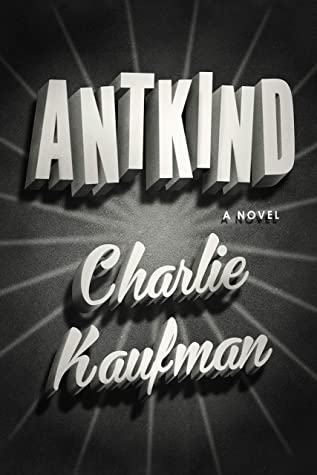Title: Antkind
Rating: 4 Stars
I’m going to write a follow-on post shortly that will dive deeper into some of the vagaries of Antkind. Here are my impressions of it.
I have no idea how to even start. I’ve written several times of the genius of Charlie Kaufman. My most recent post about him was my own personal WTF rankings of his films. I knew that he’d just completed a novel. I read enough about it to know that it was going to be a wild ride. I knew that it was a monster to read at over 700 pages.
I knew that I was going to have to read it. In all honesty, I was dreading it. Was it going to be like reading Ulysses and I would be, for the most part, wandering around lost? Was it going to be like Gravity’s Rainbow, where I could only read twenty or thirty pages at a time because my brain would get overloaded?
I shouldn’t have worried. As weird as his writing is, it is always (at least to me) entertaining. So it was here. Believe it or not, there was at least a little something on nearly every page that made me laugh. This could have been something clever, something silly, something that was blatantly bullshit, or even some good old fashioned slapstick (the protagonist falls into many, many open manholes).
Although I wouldn’t put it at the same level as Infinite Jest or Houses of Leaves, it’s in the same neighborhood. The clever (sometimes too clever) writing, propulsive (if mostly meandering) plot, and humor made it almost compulsively readable. Broken into bite size chapters, I was always left at the end of a chapter hungering for another one.
The only reason why it didn’t get five stars is because, yeah, as some of the other reviews that I’ve read commented, he probably could have used a stronger editor. I’m guessing that a hundred or so pages could have been edited out of it. Having said that, Kaufman, at least as a novel author, falls into the maximilist branch of postmodernism. Far be it for me to try to cut a maximilist’s output down to a reasonable size. It kind of defeats the point.
The plot, on its surface, is quite simple. B Rosenberger Rosenberg (definitely not Jewish!) is an underappreciated, pretentious, so so painfully woke (I have a black girlfriend!), neurotic film critic. In Florida he seemingly accidentally encounters an ancient Black man named Ingo Cutbirth. Cutbirth had spent the previous ninety years working on a silent, stop motion film that has a three month running time. Rosenberg is thrilled to view the film, seeing it as an opportunity to ride the coattails of this oppressed minority’s outsider art to critical fame and glory.
He watches the entire film (it has pre-scheduled bathroom, meal and sleep breaks). Midway through Cutbirth dies. Rosenberg, according to his process, must watch it a total of seven times (including once backwards and another time upside down). Accordingly, he packs up all of the film canisters and proceeds to head back to New York City where he’ll watch it obsessively, write about it, and become immortal.
Unfortunately, his plan goes awry when his truck goes up in flames at a fast food restaurant parking lot. He tries to save the film but succumbs to the smoke. When he comes out of his coma (suspiciously, three months later), he discovers that only one frame of the film has been saved. It becomes his life’s mission to resurrect the entire film from that frame.
From here, the plot unfolds. As you can probably guess, there are way more questions than answers. Did the film really exist (or did he imagine the entire thing while he was in a coma)? Did Cutbirth exist? If so, was he even black (sometimes he appears Swedish)? As Rosenberg undergoes deep hypnotherapy to try to rediscover the film, are the memories that he’s recovering even real? Being a film critic, Rosenberg references well over a hundred films. Which ones are real? Every page contains an obscure fact or two. Which facts are real and which ones are absolute bullshit? Will the novel end with closure (yeah, right)? Of all of the Rosenbergs that make their appearance, which is the real one and which are the clones?
As you can tell from all of this, we’re definitely living in a postmodern fictional world. Whether you enjoy it or not depends entirely upon how you feel about spending time in such a world. I don’t mind an occasionally good mind fucking, and this novel left my mind well fucked.
Regarding the blog title, this novel reminded me of a cabinet of curiosities. Centuries ago, before museums were really a thing, wealthy nobility would gather semi-random artifacts from all over the world and display them for their guests amusement and amazement. Since there really was no scientific rigor applied to these collections, they invariably were an assortment of real and fake things. After all, if you’ve never seen a picture of either, who’s to say whether a skeleton of a giraffe or of a unicorn seems more reasonable?
There are a couple of museums that still present themselves in this way. They contain artifacts that could be real or false. It is up to the museum patron to make their own decisions. I find them to be pretty wonderful places. If you ever get a chance, check out the Museum of Jurassic Technology in Venice or the Viktor Wynd Museum of Curiosities in London.
As I read Antkind, I had a similar experience. Films, novels, poems, and trivia references are strewn throughout the novel. Some I know to be true, some I know to be false, and some I have no idea. In the novel, it’s all presented the same. It’s up to you to define your own reality.
Just like being in a cabinet of curiosities.
